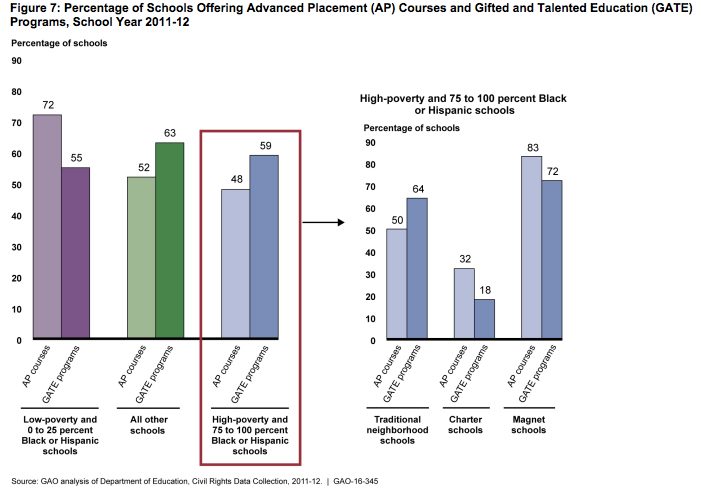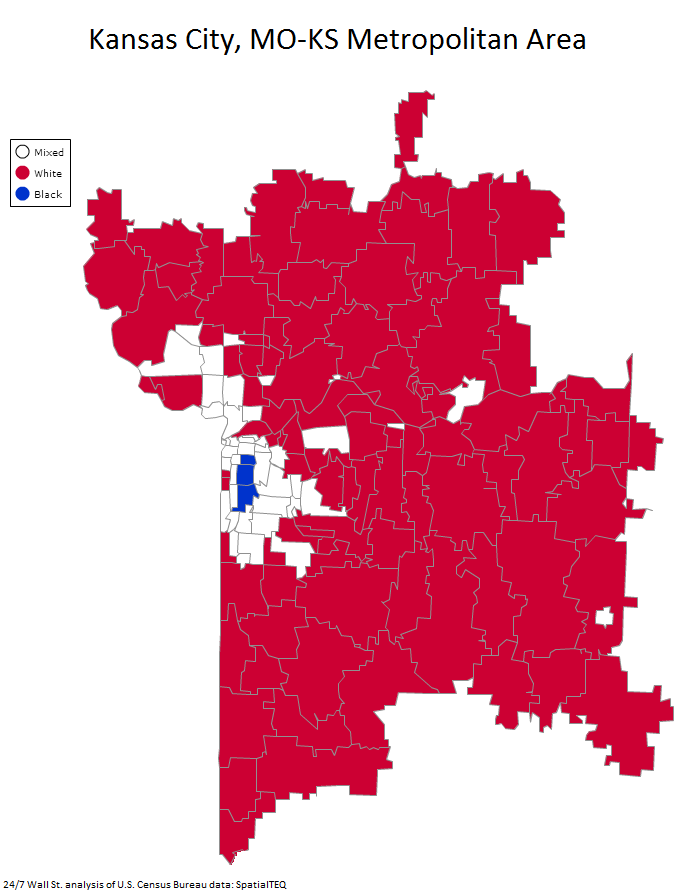
It has been 62 years since Brown v. Board of Education made segregated schools unconstitutional. Yet the number of black students attending separate and unequal institutions is on the rise, according to a new U.S. watchdog agency report.
The Government Accountability Office released its report on Tuesday, the 62nd anniversary of Brown v. Board of Education. The study is the result of a 2014 request from Reps. Robert Scott (D-Va.), John Conyers (D-Mich.) and former Rep. George Miller (D-Calif.). They wanted to learn more about the extent to which racial and economic segregation is impacting the nation's schools.
The GAO -- a nonpartisan agency designed to provide Congress with oversight -- found that schools have become increasingly racially isolated for both black and Latino students. And these institutions also routinely fail to provide students of color with the same resources given to their white counterparts.
The law no longer condones segregated schooling like it did in the days before Brown, but an insidious system of stratified schooling exists all the same. What's more, the report says governmental agencies such as the Department of Education and Department of Justice are not doing all they could to dismantle this system.
"More than 60 years after the Brown decision, our work shows that disparities in education persist and are particularly acute among schools with the highest concentrations of minority and poor students," the report's conclusion says.
This backwards procession toward school resegregation is a relatively new phenomenon after years of progress during the late 1960s,'70s and ’80s. While advancements were slow in the immediate years following Brown, legislation like the Civil Rights Act of 1964 helped speed up desegregation. However, court decisions and federal inaction during the late ’80s and ’90s helped undo much of this progress.
“I am sorry to say that the new GAO study confirms what we all suspected — schools are more segregated now than in 2000.”
- Nancy Zirkin, executive vice president of The Leadership Conference on Civil and Human Rights
Since 2001, the share of schools serving a student population that is at least 75 percent black or Latino as well as overwhelmingly poor has increased from 9 to 16 percent. In these schools, students face challenges related to both racial isolation and poverty. Latino students in these schools sometimes face "triple segregation," facing barriers not only associated with racial isolation and poverty, but also with learning a new language. And the number of schools facing the worst rates of racial isolation -- where 90 to 100 percent of students are black or Latino and low-income -- has grown by 143 percent since 2001.
These institutions increasingly look less like traditional public schools that serve kids living in specific neighborhoods. Since 2001, the share of charter schools serving high-minority, low-income populations, has grown significantly -- increasing from 3 to 13 percent. The share of magnet schools serving these students has also grown.
These changes come at the same time that the public school system overall has faced major demographic shifts. In 1975, black students represented the largest minority group in American public schools and constituted 14 percent of students. By the 2013-2014 school year, Latino students were the largest group of minority students, and comprised 25 percent of students, compared to 16 percent black students.
But no matter whether it is a traditional public school or a charter one -- which is publicly funded but privately operated -- high-minority schools still tend to receive fewer material resources, the report says. On the whole, these schools offer fewer high-level courses, as shown in the graph below. Students in these schools are also more likely to get held back or face harsh discipline like suspension or expulsion.


Research on the academic outcomes of schools with high concentrations of students living in poverty is unequivocal. Where you have high rates of poverty, you also have lower achievement results.
To help fix this two-tiered system, the GAO recommends that the Department of Education more routinely analyze its data "by school groupings and types of schools across key elements to further explore and understand issues and patterns of disparities." It advises the Justice Department to more thoroughly track federal court cases involving issues of school desegregation.
The GAO notes that the DOJ currently monitors and enforces 178 open federal desegregation court cases to which it is a party, many of which originated 30 or 40 years ago to remedy segregation. "However, GAO found that Justice does not track key summary case information, such as the last action taken in a case. As a result, some may unintentionally remain dormant for long periods," the report says.
In recent months, the Obama administration has indicated a renewed commitment to the issue of school desegregation, although few concrete actions have come to fruition. The administration's latest budget proposal includes a grant program designed to encourage school desegregation along socioeconomic lines.
“There’s no question that the urgency around socioeconomic integration in our schools is drawn not only from our desire for better academic outcomes, but also from the understanding that ours is diverse world and we must ensure our students are prepared to succeed in a diverse 21 century society,” said U.S. Secretary of Education John King at an event in April. “You can’t find the CEO of major company or president of a university who won’t tell you one of their top priorities isn’t increasing diversity.”
Congressmen Scott and Conyers held a press conference on Tuesday, where the Virginia representative reprimanded the government for failing to make progress on this issue.
“Lack of governmental action and oversight, fueled in part by hostile court decisions that made public school integration harder, not easier, have lead us to 2016: An overwhelming failure to fulfill the promise of Brown in realizing equality in educational opportunity for all students,” Scott said.
Scott and Conyers introduced a new bill in response to the report’s findings, which would allow individual civil actions in education cases involving disparate impact.
“This bill would level the playing field for parents and communities to address – through robust enforcement – racial inequities in public education,” Scott said.
Nancy Zirkin, the executive vice president of The Leadership Conference on Civil and Human Rights, an umbrella organization comprising more than 200 national organizations, lamented the study's results.
"I am sorry to say that the new GAO study confirms what we all suspected -- schools are more segregated now than in 2000," Zirkin said. "These schools and districts are educating a larger share of low-income students and students of color, but compared to their more affluent peers, have minimal access to the educational resources needed to support student success ... We must focus on fixing resource disparities that have plagued students of color and low-income students for generations."
______
Rebecca Klein covers the challenges faced in school discipline, school segregation and the achievement gap in K-12 education. In particular, she is drilling down into the programs and innovations that are trying to solve these problems. Tips? Email Rebecca.Klein@huffingtonpost.com.
______
Related Stories:

